The Evolution of Schools in Bartow County, Georgia
The First 100 Years
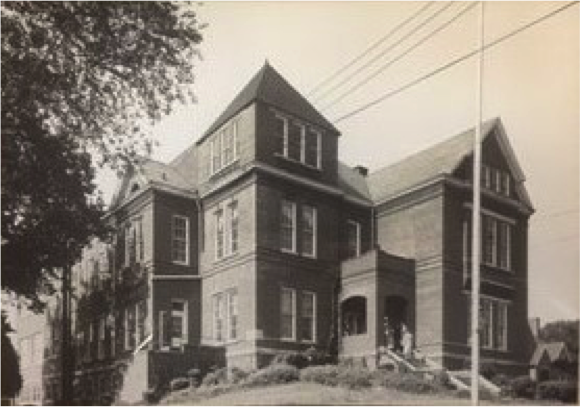
Sam Jones Female College and first Cartersville High School until 1953
Elyse Hoganson, Intern
Etowah Valley Historical Society
Georgia College and State University
HIST 4960
Dr. Jessica Wallace
July 2016
Supervised by Joe F. Head, EVHS Vice President
The Evolution of Schools in Bartow County, Georgia
The First 100 Years
The origins of education in Bartow County, Georgia, previously known as Cass County, can be partially discerned only after deeply researching archives and newspapers dating from the middle of the nineteenth to the turn of the twentieth century when schools came into the charge of the state. The birth of education in this southern agricultural county cannot be pinpointed to one school, one year, or even one community in part because of the lack of government involvement in the creation of schools, and because of the loss of records destroyed in the Civil War. From this research, one hundred and twenty one schools were found to have existed in Cass/Bartow County between the 1830 and 1930’s, excluding Native American mission schools. As a result, this examination revealed three types of institutions that were once present. These three practices were in some sequential order, but for a time overlapped one another.
PHASE 1
The first type of school that evolved from exclusive parental instruction (home schooling) was that of the one-room school houses called “old field schools”. Evidence of these schools can be found in local archives, specifically articles and advertisements from local newspapers. Old field schools were often affiliated with local churches and agriculture communities. Multiple schools were necessary in one county to accommodate the scattered population. These rural schools were unregulated by the state, but did receive some financial assistance from the local government in the form of meager teacher compensation, one of the earliest examples of public funding. Most individuals and communities in Bartow in the mid-1800’s were opposed to the notion of public schooling, and believed that the responsibility of educating ones children is that of the parents alone. A factor that highly influenced the hesitation for creating public schools was the focus and dependence on agriculture in the area, and most farming families relied on their children as a labor force to help in planting, harvesting, and tending to livestock. However, when enough community members were in favor of a public school, the smaller independent establishments often consolidated into a larger school.
PHASE 2
A second form of education in Bartow County that was more selective and difficult to track due to its short life, lack of records, and eagerness to receive compensation from the government were independent schools and academies run out of individuals’ homes, or “cottage academies.” A cottage school is one that typically was established by an educator and operated by that individual who charged tuition for attendance. In many cases these schools were considered upscale, gender specific education and may have provided optional room and board as needed. Some offered specialized courses of study in languages, arts or science. Cottage schools were found to operate primarily between the mid 1860’s and mid 1880’s. A reason why these cottage academies might have been short lived can be connected to the school’s eagerness to receive funds from the government for a school house, furniture, books, and teacher compensation. When public funding became more generously allotted, most of the cottage academies dissolved, and many of the individuals who ran a school out of their home or in a community building can be eventually traced to the establishment of a larger community school and even later to a public school. One such example is the West End Institute ran by Miss Lucy Carpenter and Mrs. J. W. Harris. These two women began their career in education with the opening of Miss Carpenter’s School on January 5, 1885. Mrs. J. W. Harris was a graduate of the Cassville Female College, and the sister of Asa Candler, the founder of Coca-Cola. Lucy Carpenter was a well-liked teacher in the community. This school was conducted in a former Methodist church in Cartersville, Georgia. Miss Carpenter’s School later became known as the Church Street School as it was advertised in October 1885. In 1886, Mr. and Mrs. Harris chartered the West End Institute where Miss Carpenter and Mrs. Harris were principals. The West End Institute supplied board for the students and offered courses in music, art, and foreign language. This category of school offered direction in niche subjects to students whose guardians were willing to pay tuition. Cottage academies were perceived to offer a more elite
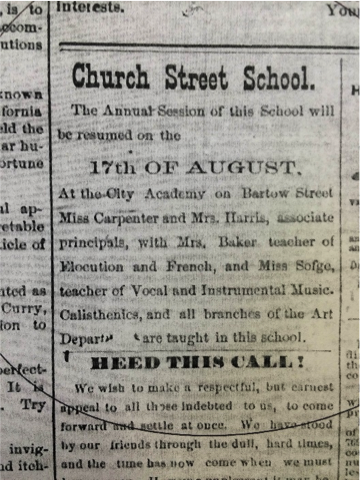
Cartersville American 10/27/1885
curriculum in comparison to those community schools operated in rural schoolhouses and church buildings. Once the creation of public schools began, most of these cottage academies dissolved; however, some students continued to attend private schools. This example of a cottage academy signifies the common evolution of schools in Bartow.
PHASE 3
The third form of education surfaced in the 1880s when the state government took interest in public education. This third phase of schools can be categorized as a transition between old field schools and cottage academies, leading up to the full-blown public schools that we know today. This third phase appears to be a hybrid of the previous types of schools and public schools because many institutions in the late 1800’s received some funding from the local government, but they were still mostly tuition-based and financially supported by members of the community. This transitional phase encompasses various types of schools that differed in the rigor of instruction as well as the physical structure. Some were run out of residences while others operated in buildings crafted specifically for the school. This third phase is difficult to pinpoint because a common goal among the various schools in this category was to obtain state funding, which would lead to their eventual evolution into public institutions. One example of a hybrid school was the East Cartersville Institute. When the West End Institute was in operation in Cartersville, the East Cartersville Institute existed on the other side of town on Gilmer and Carter Streets. In 1883, the East Cartersville Institute was supervised by the principal Prof. Matthew Marshall. The patrons of this school received the benefit of the Public School Fund, but still required tuition.
PUBLIC OPINION
While there were many who favored the establishment of a public school system, there was still a majority who believed that education was the responsibility of the parents and guardians. In an article from the September 18, 1873 edition of Standard and Express newspaper, public education is criticized, and the author even suggests that if it is the duty of the tax payers to take responsibility for the education of children then shouldn’t “taxpayers also employ public preachers to teach moral and religious culture to the children?” The views in this article expressed the concerns of many Georgians who did not support public education. Old field schools, cottage academies, and public schools did coexist, however, there is a distinct difference between these types, and the timeline of education in the county shows a major shift in interest from one type to the next. [1]
OLD FIELD SCHOOLS
The first schools in Bartow County cropped up in the years before the Civil War, or the War Between the States. Some of the families in the various communities around the county decided to form a community school for their children to attend, often being influenced by the local church. Being a farming community, these rural schools did not enforce attendance or have a uniform curriculum. During harvest and planting seasons children were needed at home to help with the work and attended school as farming chores allowed. Teachers with degrees or exceptional credentials were extremely hard to find. Most teachers of the old field schools were women of the community, wives, daughters, and sisters who were homeschooled or self-taught. Although the subjects varied in each school and depended on the knowledge of the teacher, there was an emphasis on reading, writing, and arithmetic. Other subjects included domestic sciences, language, and music. Those institutions that were created by or operated out of the local church also included lessons in religion and bible study. The presiding reverend of the local church often taught at these community schools, too. In this time, educators were also known to travel throughout the state and settled wherever they could convince parents in a community to hire them to teach. Many of these teachers were university graduates, or graduates of a normal school, unlike the local teachers who were comparatively under qualified. [2] For this reason, travelling professors were successful in establishing cottage academies and convincing parents to enroll their children.
One of the earliest schools in Bartow County was The Cassville Academy established in 1833. Little is known about this school other than a report in 1838 stating that the school had 60 students. The creation of this school resulted from an act of legislation. Raccoon Creek School and Macedonia School were two old field schools in Bartow County in the 1840’s. Raccoon Creek School was taught by Rev. Nathan Smith in Raccoon Creek Baptist Church located near Stilesboro, and the first Macedonia School of two was created by the community of the Macedonia Baptist Church in west Bartow. The Macedonia School closed during the Civil War, and was likely destroyed by Union soldiers in May 1864. The second Macedonia School was operating in 1913 in east Bartow
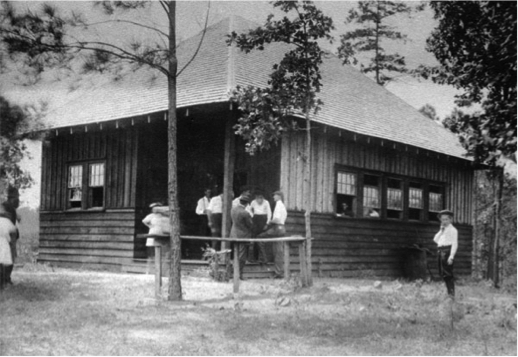
East Macedonia School
County, southeast of Center. Stamp Creek School in White, Georgia was open in the late nineteenth century. The Boston-Brooke School was built in 1848 by Frederick Auton Boston in the Stamp Creek community of Bartow County. The first teacher of this school was W. C. Brooke who aided in the construction of the log building. This community school also served as a meeting house and a polling place for local elections. Unlike most schoolhouses, the Boston-Brooke School survived the Civil War and even served as a holding place for captured Union soldiers. The schoolhouse remained standing until December 1999 when it burned. Adairsville Academy, often referred to as The Academy, was opened in the late 1870’s. The name was changed in 1910 to the Cherokee Institute, and in 1916 the school was sold to the city of Adairsville. It consolidated into the Bartow Rural High School in 1939. An old field school, or rural community school, called the Busy Bee School was founded in 1897 in Adairsville by Mrs. McCants and her daughter, Addie. According to an article from a local newspaper, the school operated out of a few different buildings, with one being located at the intersection of Main Street and Summer Street.
In Kingston, Georgia, there existed a school that serviced the youth in the community known as the Kingston Academy. Opened in 1857, this school survived the Civil War and continued to operate in 1876. Kingston Academy was taught by J. T. Lin in 1876, and was described in a newspaper advertisement from the Cartersville Express to have, “No liquor shops, gaming tables or sickness. Good water – good churches – refined society.” This school also offered board for the students. Another school was taught by Mrs. C. N. Mayson in Kingston after the war. Her school strived to assist those who were found handicapped as a result of the war. Kingston High School was established in the early 1900’s. The frame school building burned down after 1911 and was rebuilt out of brick.
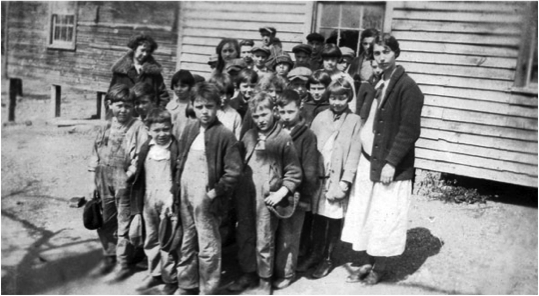
Five Forks School
Miss Gena Moon opened the Leeks School on July 24, 1905 in Cartersville, and in the neighboring community of Five Forks, a school was operating under Mr. W. F. Freeman as principal.
COTTAGE ACADEMIES
Rev. Charles Wallace Howard established a girl’s school north of Kingston called Spring Bank in 1853. Martha Berry was a student of Spring Bank and went on to found Berry College in Rome, Georgia. A boy’s school founded in Kingston by the name of Goulding House, was ran by Rev. F. R. Goulding, a bestselling author and the inventor of the first sewing machine. Both schools closed during the war, but Spring Bank reopened and operated years after Rev. Howard’s death in 1876. Spring Bank and Goulding House are notable schools for the area because they were taught by prominent men of the community and could be considered cottage academies.
In 1868, an ad appeared in local newspapers for the Female High School in Cartersville under the supervision of the principals, Rev. O. L. Smith, D. D. and Rev. F. P. Brown, A. M. In the same year the Cartersville Male Academy lists Rev. Smith and Col. Pritchett as the overseers. Four years later, advertisements for two more schools
Goulding House
were displayed together titled, Cartersville Male High School under the charge of R. Johnston, principal and Cartersville Female Seminary taught by Misses Moon and Safford. The life stories of Misses Lottie Moon and Abby Safford are well-known in the Bartow County community. Lottie Moon was a popular school teacher in the southeast U.S. during her lifetime, but she is even better known for her missionary work in China. In an advertisement from 1873, the Cartersville Female Seminary listed Mrs. S. F. Brame and Miss Julia Sims as principals. Mrs. Brame previously operated her own female institute and would later teach at the West End Institute with her niece, Mrs. Harris.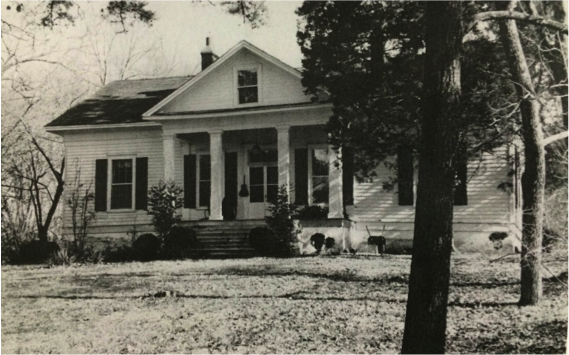
Mrs. Brame’s Female School is a perfect example of a cottage academy that operated in 1872 in Cartersville. Like most private academies, Mrs. Brame offered lessons in the traditional academics, as well as, lessons in music and language. The Kindergarten system of teaching was started in Mrs. Brame’s school in 1885 by Mademoiselle V. Goulong. Students were welcome to board with the best families in town in convenient distance to the Academy. Mrs. Brame was connected to a prominent family in Bartow County’s history, and her efforts in the education of the county’s youth, aided in enrichening the county’s culture. Sarah Frances Brame was born Sarah Frances Beall, sister to Martha Bernetta Beall Candler who was the mother of Florence Candler Harris and Asa Candler, founder of Coca-Cola.
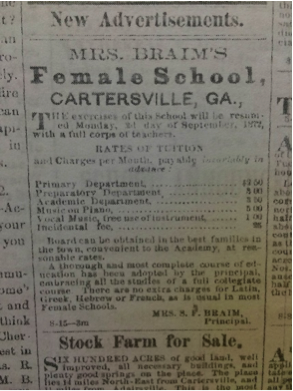
Standard and Express 8/15/1872
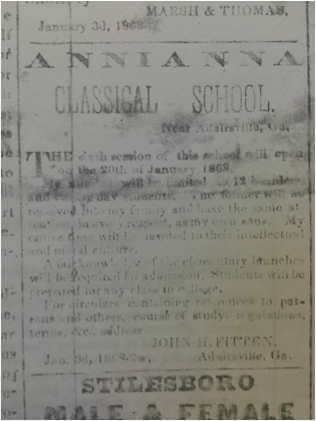
The Cartersville Express 1/4/1868
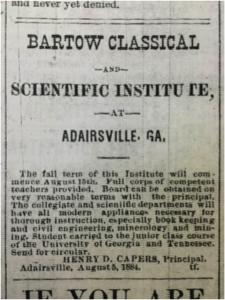
Cartersville American8/5/1884
Adairsville had its own institutions, one of them being the Bartow Classical and Scientific Institute. This school for boys operated in the mid-1880’s under the principal, Henry D. Capers. Board was offered for the students with the principal, and like all other private academies, tuition was charged by the term. Another private institute in Adairsville was the Annianna Classical School. Annianna was in operation in 1868 under the supervision of John H. Fitten. Classes were held in the Charles Hamilton home in north Adairsville. The number of students was limited to 12 day students and 12 boarders who stayed with Fitten and his family. In 1852, J. S. Lassiter taught a Mathematical School in Cassville that he characterized as, “Teaching done entirely by analysis.” This school offered mathematical lessons taught during a traditional term or private tutoring sessions. A common tactic for schools in the late nineteenth century was to list prominent men in the town as references in advertisements to bolster the credibility of the school. Lassiter listed Rev. G. W. Tumlin, Hon. Lewis A. Tumlin and James T. Livingston, Esq. In the same year, there was a school operating four miles from Cassville under the name of Two Run Academy. This school was taught by William P. Fain. While little is known about Two Run Academy, an article in The Standard on June 24, 1852 that lists the courses offered at the school; spelling, reading, composition, arithmetic, grammar, natural history, and Latin, suggests that this school was a cottage academy rather than a rural community school.
Most of the cottage academies cropped up in the 1880’s, and a few influential ones were detailed in an article from the Cartersville American on October 21, 1884. Both Mrs. Brame’s School and Miss Carpenter’s School were listed as well as Mrs. Baker’s School, Mrs. Bell’s School, Mr. Maddox’ School, and Moon and Mountcastle’s School. Mrs. J. A. Baker taught a school out of her home on West Main Street in Cartersville which was able to accommodate 25 students. She was praised in the article for her happy faculty and way with children. Baker was an 1876 graduate of Wesleyan Female College. Mrs. Bell’s School was located on Gilmer Street in Cartersville, and it serviced the children of the neighborhood. George W. Maddox was well known in Cartersville for teaching before and after the war, and he established his school in the southeastern part of the city. The last school mentioned in the article was said to have recently been established by Mr. John L. Moon and Mr. H. M. Mountcastle. This school operated on Douglas Street in Cartersville, and during this time, there was discussion over opening a night school for men who worked during the day. The Hillyer’s Male School was a cottage academy in Cartersville operating in 1872. Asa Candler, the founder of Coca-Cola, attended Hillyer’s School under the supervision of S. G. Hillyer, Jr during Asa’s three years spent in the county. Between 1870 and 1873, Asa Candler trained as a pharmacist in addition to attending school in Cartersville.
HYBRID SCHOOLS
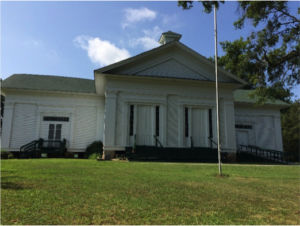
Stilesboro Academy 2016
Stilesboro Academy opened in 1859 and was spared by General Sherman in the Civil War because the school’s motto featured above the door, “Deo ac Patriae,” or “God and country,” was the same as that of West Point Military Academy. A petition for charter was granted for Stilesboro Academy on January 27, 1892. The Stilesboro Male and Female Institute, was open in 1868 under the care of the principal, J. G. Ryals, and his assistant, W. J. McCormick. Mrs. Ryals also taught music at this school. Stilesboro High School opened in the 1880’s, and the Stilesboro and Davis school districts consolidated into one school in 1938, operating out of the old Stilesboro Academy.
In Cassville, Gen. Wofford donated land to the community for the purpose of building an academy, a church, and a Sabbath school. The academy that resulted was Wofford Academy. The school was granted a charter in 1890, but the school was operating in 1877. Boarding for the students could be found with the families of Cass Station or with the principal. In 1880, the

Euharlee School
principal was Prof. Matthew Marshall. The Sabbath school that was built was known as the Cassville M. E. Sabbath School, and in 1886 it ran under the superintendent, Dr. M. S. Browne. Wofford Academy burned down sometime between 1900 and 1905, and was replaced by the Cass Model School built in 1908. Cass Model School was under the management of the Bartow County Board of Education. The Euharlee School opened in Euharlee, Georgia on February 1, 1870 in a new building built specifically for the purpose of this school. The students were under the charge of J. H. Harris, graduate of Columbia College, South Carolina. Room and board was offered to students from $10-$12 per month. Eight miles west of the Cartersville Depot was the Mount Paran Academy built by the Mt. Paran Baptist Church. Mt. Paran was advertised in The Standard on March 4, 1852 listing Mr. and Mrs. R. F. Neely as its newest teachers. One account of these Euharlee schools pose the question of whether Mt. Paran Academy and Euharlee School were two names for the same institution, but records do not indicate a definitive answer. The Euharlee Institute opened on October 15, 1896, and a petition for charter was granted to the Euharlee Presbyterian Institute that same year. In 1913-1914, Euharlee Institute became the Bartow Rural High School under the Bartow County Board of Education. The school was open to both boys and girls, and board was offered for the students. The Pine Log Male & Female School near Pine Log, Georgia was in operation in 1868 under the principal, T. M. Fulton. Students of this school could receive board for $10-$12 a month. Nathaniel E. Harris, governor of Georgia and founder of the Georgia Institute of Technology, attended a school in Pine Log in the 1860’s called Martin Academy. A third school that formed in Kingston was the Whittenberg School opened in 1900 by Prof. and Mrs. W. V. Whittenberg. This school received the benefits of the public school fund. In 1875, the Erwin Street School was run by the principal, L. B. Millican and Mrs. M. G. Millican assisted him. First through Third Grade was taught at the Erwin Street School, and patrons of this school received the benefit of the public school fund. A school on Gilmer St. in Cartersville was the Due West School, operating in 1873. J. W. Pritchett was the principal of this school, and two teachers were Miss Sallie Trotter and Mrs. M. P. Godfrey. Due West School was unusual amongst the schools of its time because it was co-ed. New Hope Academy was operating near Cartersville in 1876 where Irby G. Hudson was principal. The Bates School was operating in 1915 in South Bartow and was moved to Emerson, Georgia in 1930.
PUBLIC SCHOOLS
In September 1889, two public schools for white children were opened in Cartersville on opposite ends of the town. The East Side School used the old East Cartersville Institute building, and the West Side School operated out of the old Sam Jones Female College building. Cartersville High School would later use that same building until 1953 when the new Cartersville High School was constructed. On Gilmer Street there existed a boarding house for students and laborers called Gilmer Hall. It is possible that the students who lived in this building attended one of the
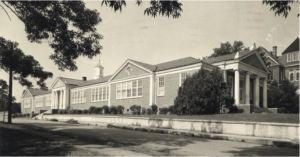
Cherokee Avenue School
various schools located near Gilmer Street. The Douglas Street School was in operation in the early twentieth century, and it was later called Cartersville Primary School. The Douglas Street School was operating in Cartersville in 1934, as was the Market Street School, also known as the Cherokee Avenue School. Both of these schools taught First through Seventh Grades.
BLACK SCHOOLS
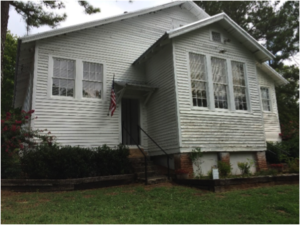
Noble Hill 2016
Before and during the Civil War it was illegal in the southern states to educate blacks, so one will not likely find records of black schools before the 1880’s. The first black school in Cassville was located near New Hope Baptist Church. In the same area was the Cassville Colored School which was open from the 1880’s until 1921. In 1923, a new school was built to replace Cassville Colored School, with help from the Rosenwald school fund, called Noble Hill. Dr. Rosenwald and Booker T. Washington funded the creation of 5,000 black schools across the southeast U.S. Rosenwald was the part-owner of the Sears, Roebuck and Company and a philanthropist. Noble Hill is one of 53 Rosenwald schools still standing. Noble Hill School operated until 1955 when it consolidated with the Bartow Elementary School. Another black school was located west of Kingston located on the Gordon-Wooley property off of Tom Jones Road called the Gordon School which operated in the 1920’s. Some other black schools in Bartow County were The Mission School, Brown’s Chapel, Conasene, Corinth, and Shiloh Baptist. A Brown’s Chapel schoolhouse existed prior to 1916, but that year representatives of the school asked the Bartow County Board of Education to provide arrangements for a new school in exchange for the deed to the land. In 1917, the black community of Rogers Station in Bartow County appeared before the County Board of Education with the intention of building Connesena Colored School. The community had raised $200 for the building of the school, and they requested a $100 contribution from the Board to meet the requirements of the Rosenwald fund. The Corinth Baptist Church operated a school for the black community in the 1930’s. This school closed in 1938 due to a school consolidation. Shiloh Baptist Church operated a school in the 1940’s near Stilesboro. The Mission School was established by The Mission African Methodist Church around 1928.
COLLEGES
A few colleges existed in Bartow County in the middle to late nineteenth century, but like the academies and old field schools, there was no standard curriculum or credentials that further classify these schools as colleges besides the name and the understanding that they offered a higher level of learning than the academies and high schools. Despite this, the colleges of Bartow County were the pride and joy of the county, and they were known around the country, evidenced by articles and advertisements from various newspapers in Georgia, like New London Daily Chronical in 1856 and the Charleston Courier in 1854. In the early 1850’s the members of Cassville made plans for the creation of two institutions of higher learning, one for boys and one for girls. The intention of these schools was to become state-renowned and the first of their kind in north Georgia. There were already two comparable schools in the county, a girls’ institute run by Mrs. S. S. Bradley and a boys’ institute run by Mr. and Mrs. R. F. Neely. Mr. Neely was a graduate of Trinity College in Dublin, Georgia, and his wife was a graduate of the Staunton Female Seminary in Virginia. The new boys’ school in Cassville came under the care of the local Baptist community and was dubbed the Cherokee Baptist College, while the girls’ school was associated with the local Methodist church and was called the Cassville Female College. The Cassville Female College began its first term in 1853 with Rev. Rogers, president, Rev. A. G. Johnson, professor of English and Latin Literature, S. G. Smith, professor of vocal and instrumental music, Mrs. E. Louisa Smith, principal preparatory department, and Mrs. E. L. Smith, principal ornamental department. The Female College offered board with the family of the President. The school was located on the west side of town on land donated by Judge Nathan Land. The two colleges in Cassville began construction around the same time and were due to open within months of each other, but the Cherokee Baptist College burned down prior to its completion, most likely from a neglected workman’s pipe, described by Joseph B. Mahan, Jr. in A History of Old Cassville 1833 – 1864. The male college was rebuilt and operated until the Civil War. Gen. Sherman’s troops destroyed the city of Cassville, along with its two colleges that had been used as hospitals during the war. In 1886, Rev. Sam P. Jones of the Cartersville Methodist church in Cartersville announced in one of his sermons the need for a college in the town, and soon the building of the Sam Jones Female College was underway. In 1904, a college was established in Pine Log. The college was not controlled by any religious denomination, stated in an article from The News and Courant on June 2, 1904. The building for Pine Log College was intended to be “two stories high with a wing branching off from each side.”
MODERN PHASE
The third phase of schools introduced public funding to the existing institutions, and brought on the next phase of education that still exists today: public funded schools based on taxes that enforced compulsory education. Between 1783 and 1817 all money for education from the state and local governments went to the academies, leaving none for rural community schools, but in 1822 the Poor School fund was created to support free schools throughout the state. In 1823, school districts were established within each county, and the county was given permission to levy taxes for the operation of the schools. The Poor School Fund existed as a precursor to the rise of public funding from the government, however, the legislation was disrupted by the Civil War, and was implemented again in 1866 mandating a free public school system. Some schools that can be classified into the modern phase still exist in some form today. Cartersville High School moved into the building it still uses today in
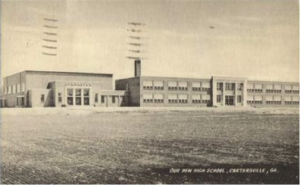
Cartersville High School 1953
1953, and in 1935 the small rural schools of Cross Roads, Davis Town, Big Pond, and Ligon consolidated with the Taylorsville School. Many of the county rural schools like Euharlee and Adairsville consolidated into the Bartow Rural High School which opened in 1913-14.
This has been a landscape study dedicated to the discovery of how Bartow County schools evolved from its establishment in 1832. The research uncovered a variety of systems and phases that once delivered education to scattered populations and revealed local solutions over the first 100 years. It is hoped that this research has added to the existing knowledge of how schools evolved in Bartow County, as well as, exposed the priorities of the population and innovations that emerged during the evolution of schools in the area. It is also hoped that the explanations and discovery provided for the type of schools named here as cottage academies informs the public of how education was valued in the community and contributed to the culture of Bartow County today.
AUTHOR’S NOTE
The research that I have conducted over the past month has made me feel more connected to my hometown of Cartersville than ever before, and has enlightened me on the evolution of a vital component of the county’s culture.
APPENDIX A
All Schools in Bartow County 1840-1940
Key:
- Old Field Schools: support originated from pooled community and rural resources to build and fund instruction.
- Cottage Academies: typically offered upscale curriculum, required tuition, and offered optional room and board.
- Hybrid: schools in the transitional phase before modern schools.
- Public: state funded, compulsory education.
| SCHOOL | YEAR | LOCATION | TYPE |
| Adairsville Academy | Late 1870’s | Adairsville | Old Field School |
| Adams Chapel | 1900 | Euharlee | Hybrid |
| Allatoona | 1910 | Allatoona | Hybrid |
| Allatoona | 1935 | Allatoona | Public |
| Annianna Classical Institute | 1868 | Adairsville | Cottage Academy |
| Atco School | 1904 | Cartersville | Hybrid |
| Barnsley School | 1888 | Barnsley Estate | Old Field School |
| Bartow Classical and Scientific Institute | 1881 | Adairsville | Cottage Academy |
| Bartow Rural High School | 1913 | Euharlee | Public |
| Bates School | 1915, moved 1930 | South Bartow, Emerson | Old Field School |
| Bethany School | 1900 | Red Top Mt. | Old Field School |
| Big Pond School | 1888-1937 | Taylorsville | Old Field School |
| Boston-Brooke School | 1848 | Stamp Creek | Old Field School |
| Brown’s Chapel | 1916 | N/A | Black School |
| Busy Bee School | 1897 | Adairsville | Old Field School |
| Cartersville Academy (coed) | 1869 | Cartersville | Old Field School |
| Cartersville Female High School | 1868 | Cartersville | Hybrid |
| Cartersville Female Seminary | 1873 | Cartersville | Cottage Academy |
| Cartersville Male Academy | 1868 | Cartersville | Hybrid |
| Cartersville Male High School | 1872 | Cartersville | Public |
| Cassville Academy | 1833 | Cassville | Cottage Academy |
| Cass Consolidated High School | 1931 | Cassville | Public |
| Cass Model School | 1908 | Cass Station | Public |
| Cassville Female College | 1854 | Cassville | College |
| Cassville M. E. Sabbath School | 1873 | Cassville | Old Field School |
| Cassville Mathematical School | 1852 | Cassville | Cottage Academy |
| Cement School | Unknown-1911 | NF | NF |
| Center School | 1910 | Cartersville | Old Field School |
| Cherokee Avenue School | 1930 | Cartersville | Public |
| Cherokee Baptist College | 1857 | Cassville | College |
| Cherokee Baptist High School | 1901 | Cassville | Hybrid |
| Cherokee Institute | 1910 | Adairsville | Hybrid |
| Church Street School | 1885 | Cartersville | Cottage Academy |
| Conasene | 1917 | N/A | Black School |
| Corinth | 1930’s | Cartersville | Black School |
| Corbin School | NF | NF | Old Field School |
| Crossroads School | Late 1800’s | Taylorsville | Old Field School |
| Cunningham School | 1915 | North Bartow | NF |
| Davis School | 1886 | Cartersville | Old Field School – Old Alab – Hwy 113 |
| Dewey School | Unknown-1923 | White | NF |
| Douglas Street School | 1907 | Cartersville | Public |
| Due West School | 1873 | Cartersville | Hybrid |
| East Cartersville Institute | 1883 | Cartersville | Hybrid |
| East Side School | 1889 | Cartersville | Public |
| Erwin Street School | 1876 | Cartersville | Hybrid |
| Etowah School | 1840’s | NF | NF |
| Euharlee Elementary School | NF | Euharlee | NF |
| Euharlee Institute | 1896 | Euharlee | Old Field School |
| Euharlee Male and Female School | 1867 | Euharlee | Old Field School |
| Fairview School | Late 1800’s | Kingston | NF |
| Five Forks School | 1905 | Cassville | Hybrid |
| Flexatile School | 1906 | Northeast Bartow | Old Field School |
| Folsom School | 1920 | Folsom | Old Field School |
| Ford School | 1840 | Stilesboro | Cottage Academy |
| Gilmer Street School | 1875 | Cartersville | Public |
| Gore Springs | NF | NF | NF |
| Gordon School | 1920’s | North of Kingston | Black School |
| Goulding House | 1854 | Kingston | Cottage Academy |
| Henderson School | 1884 | Taylorsville | Old Field School |
| Hendricks School | 1840 | White | Old Field School |
| Hillyer’s Male School | 1870 | Cartersville | Cottage Academy |
| Kingston Academy | 1857 | Kingston | Hybrid |
| Kingston Elementary School | NF | Kingston | NF |
| Leek School | 1905 | Cartersville | Old Field School |
| Liberty Hill School | 1889 | Cartersville | Old Field School |
| Ligon School | 1890 | NF | Old Field School |
| Linwood School | NF | Kingston | Old Field School |
| Macedonia School | 1845 | West Bartow | Old Field School |
| Macedonia School | 1912 | Stamp Creek | Old Field School |
| Market Street School | 1934 | Cartersville | Public |
| Martin Academy | 1860’s | Pine Log? | NF |
| Mission School | 1928 | N/A | Black School |
| Moon and Mountcastle School | 1884 | Cartersville | Cottage Academy |
| Mt. Paran Academy | 1852 | Cassville | Cottage Academy |
| Mt. Pleasant School | 1908 | NF | Old Field School |
| Mr. Maddox’ School | 1884 | Cartersville | Cottage Academy |
| Mrs. Baker’s School | 1884 | Cartersville | Cottage Academy |
| Mrs. Bell’s School | 1884 | Cartersville | Cottage Academy |
| Mrs. Bradley’s Female Institute | 1852 | Cassville | Cottage Academy |
| Mrs. Brame’s Female School | 1871 | Cartersville | Cottage Academy |
| Mt. Pisgah School | 1920’s | Cartersville | Old Field School |
| New Hope Academy | 1876 | Cartersville | Hybrid |
| Noble Hill | 1923 | Cassville | Black School |
| Oak Grove School | 1890’s | West Bartow | Old Field School |
| Oak Hill | 1892 | Northeast Bartow | Old Field School |
| Oak Hill | 1870’s-80’s | West Bartow | Old Field School |
| Oakland Institute | 1847-1849 | Rowland Springs | Cottage Academy |
| Patterson Grove | 1905 | NF | Old Field School |
| Peeples Valley | NF | NF | NF |
| Pettit School | 1898 | Cassville | Hybrid |
| Pine Forrest School (Pine Grove Rd) | 1915 | Cartersville | Old Field School |
| Pine Log College | 1903 | Pine Log | College |
| Pine Log Male and Female School | 1868 | Pine Log | Hybrid |
| Pine Log Masonic Institute | Early 1870’s | Pine Log | Hybrid |
| Pleasant Valley | 1865 | Adairsville | Old Field School |
| Powelton Classical Institute | 1845 | Powelton | Cottage Academy |
| Pritchettville Academy | 1873 | NF | NF |
| Puryear School | 1935 | Southeast Bartow | Public |
| Raccoon Creek School | Early 1840’s | Stilesboro | Old Field School |
| Ransom School | 1875 | West of Kingston | Cottage Academy |
| Rebecca School | 1900’s-1930 | Cassville | Hybrid |
| Reynolds School | 1922 | Near Kingston | Old Field School |
| Rowland Springs Select School | 1858 | Rowland Springs | Cottage Academy |
| Salacoa School | 1915 | Northeast Bartow | NF |
| Slate School | 1906 | NF | Hybrid |
| Smithville School | 1940’s | Cartersville | Hybrid |
| Snow Springs School | 1905 | Northwest Bartow | Hybrid |
| Spring Bank | 1853 | Kingston | Cottage Academy |
| Stamp Creek School | Late 1800’s | East Bartow | Old Field School |
| Stilesboro Academy | 1859 | Stilesboro | Old Field School |
| Stilesboro High School | 1880’s | Stilesboro | Hybrid |
| Stilesboro Male and Female Institute | 1859 | Stilesboro | Hybrid |
| Stoner School | Unknown-1930 | NF | NF |
| Summer Hill | 1930’s | Cartersville | Black School |
| Taylorsville | 1900 | Taylorsville | Hybrid |
| The Finishing School | Before 1861 | Kingston | Cottage Academy |
| Two Run Academy | 1852 | Cassville | Cottage Academy |
| Union Hill | 1917 | Kingston | Old Field School |
| West End Institute | 1884 | Cartersville | Cottage Academy |
| West Side School | 1889 | Cartersville | Public |
| White | 1890’s-1973 | White | Hybrid |
| Wofford Academy | 1873 | Cassville | Hybrid |
APPENDIX B
Cottage Academies
| SCHOOL | YEAR | LOCATION |
| Ford School | 1840 | Stilesboro |
| Powelton Classical Institute | 1845 | Powelton |
| Oakland Institute | 1847-1849 | Rowland Springs |
| Spring Bank | 1853 | Kingston |
| Cassville Academy (Incorporated) | 1833 | Cassville |
| Cassville Mathematical School | 1852 | Cassville |
| Mt. Paran Academy | 1852 | Cassville |
| Mrs. Bradley’s Female Institute | 1852 | Cassville |
| Two Run Academy | 1852 | Cassville |
| Goulding House | 1854 | Kingston |
| Rowland Springs School | 1858 | Rowland Springs |
| The Finishing School | Before 1861 | Kingston |
| Annianna Classical School | 1868 | Adairsville |
| Hillyer’s Male School | 1870 | Cartersville |
| Mrs. Brame’s Female School | 1871 | Cartersville |
| Cartersville Female Seminary | 1873 | Cartersville |
| Ransom School | 1875 | West of Kingston |
| Adairsville Academy | Late 1870’s | Adairsville |
| Bartow Classical & Scientific Institute | 1881 | Adairsville |
| Moon & Mountcastle’s School | 1884 | Cartersville |
| Mr. Maddox’ School | 1884 | Cartersville |
| Mrs. Baker’s School | 1884 | Cartersville |
| Mrs. Bell’s School | 1884 | Cartersville |
| Church Street School | 1885 | Cartersville |
| West End Institute | 1884 | Cartersville |
APPENDIX C
Colleges
| Cassville Female College | 1853 | Cassville |
| Cherokee Baptist College | 1853 | Cassville |
| Pine Log College | 1904 | Pine Log |
| Sam Jones Female College | 1886 | Cartersville |
ACKNOWLEDGEMENTS
Etowah Valley Historical Society Archives and Library
Bartow History Museum Archives
Euharlee History Museum Archives and Library
Noble Hill Memorial Center
Kingston Women’s History Museum
Cartersville City School Superintendent Office
Bartow County Superintendent Office
The Stilesboro Improvement Club
Summer Hill
Mr. Wesley Lamar Harris
Mr. Guy Parmenter
Mr. Sam Graham
Ms. Suzanne Brock
*Special Thanks to Intern Supervisor Mr. Joe F. Head for his welcoming and encouraging attitude, his devotion to this particular project and my needs, as well as his devotion to Bartow County and its history.
BIBLIOGRAPHY
The Heritage of Euharlee, Stilesboro, and Taylorsville, Georgia, Euharlee Historical Committee, 2010, (Stars Printing Co., Acworth, GA).
Bartow Rural High School 1915-1916, Bartow Tribune Print, (Cartersville, GA).
Wesley Lamar Harris, Taylorsville High School 1900-1966, 2nd Edition, (Cartersville, Ga: McStatts Printing, 2012).
Lucy J. Cunyus, History of Bartow County, Georgia, Formerly Cass County, (Tribune Publishing Co., Inc. 1933).
Cartersville Public Schools Centennial 1888-1988, (McStatt’s Printing Co., Inc.).
The History of Euharlee, The Euharlee History Committee. (Cullman, Al: Gregath Publishing Co., 1994).
Thomas A. Scott, Interview with Dr. Susie Wheeler No. 3, 2000.
Oscar H. Joiner, A History of Public Education in Georgia 1734 – 1976, (Columbia, SC: The R. L. Bryan Company, 1976).
Joseph B. Mahan, Jr., A History of Old Cassville 1833 – 1864, (Acworth, Ga: Star Printing Co., 1994).
Grant, Chris, “Education Reform,” New Georgia Encyclopedia, (2014), accessed August 5, 2016, http://www.georgiaencyclopedia.org/articles/education/education-reform
[1] In 1916, compulsory education for children between the ages 8 and 14 was enacted by the state legislation in Georgia’s first statewide education initiative. Public funding was introduced in Bartow County prior to this legislation, so it was financially feasible for most children to attend school by this point. Chris Grant, “Education Reform.”
[2] Normal Schools were used throughout the United States in the nineteenth century to educate teachers and establish teaching standards in the hopes of standardizing schools in the country. While Normal Schools existed across the country, not all teachers attended these schools or teaching colleges, especially teachers from smaller rural towns. Encyclopedia Britannica, “Normal School Teacher Education,” 2009.
[envira-gallery id=”43760″]

